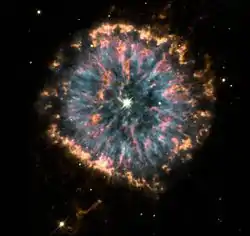NGC 6751
NGC 6751, also known as the Glowing Eye Nebula or Dandelion Puffball Nebula, is a planetary nebula in the constellation Aquila. The nebula is estimated to be around 0.8 light-years in diameter. The star at the centre of the nebula has a surface temperature of approximately 140,000 K. It has been calculated to be roughly 6,500 light-years away from Earth. It was formed when a star collapsed and threw off its outer layer of gas several thousand years ago.
| Emission nebula | |
|---|---|
| Planetary nebula | |
 | |
| Observation data: J2000.0 epoch | |
| Right ascension | 19h 5m 55.6s[1] |
| Declination | −5° 59′ 32.9″[1] |
| Distance | 6.500 ly |
| Apparent magnitude (V) | 11.9[2] |
| Apparent dimensions (V) | 0.43' |
| Constellation | Aquila |
| Physical characteristics | |
| Radius | 0.4 ly |
| Absolute magnitude (V) | 0.4 |
| Designations | Glowing Eye Nebula, GSC 05140-03497, PK 029-05 1, PN Th 1-J, CSI-06-19031, HD 177656, PMN J1905-0559, PN Sa 2-382, EM* CDS 1043, HuLo 1, PN ARO 101, PN G029.2-05.9, GCRV 11549, IRAS 19032-0604, PN VV' 477, SCM 227, GSC2 S3002210353, 2MASX J19055556-0559327, PN VV 219, UCAC2 29903231 |
The nebula was the subject of the winning picture in the 2009 Gemini School Astronomy Contest, in which Australian high school students competed to select an astronomical target to be imaged by Gemini.
NGC 6751 is an easy telescopic target for deepsky observers because its location is immediately southeast of the extremely red colored cool carbon star V Aquilae.
According to Harold Corwin, the NGC object NGC 6748 is equal to NGC 6751.[3]
See also
References
- "SIMBAD Astronomical Database". Results for NGC 6751. Retrieved 2007-04-27.
- "NGC/IC Project". Archived from the original on 2009-12-01. Retrieved 2010-01-01.
- "Notes on the NGC objects, particularly those missing, misidentified, or otherwise unusual (ngcnotes.all)". Historically-aware NGC/IC Positions and Notes. Retrieved 2019-08-10.
External links
 Media related to NGC 6751 at Wikimedia Commons
Media related to NGC 6751 at Wikimedia Commons- 2009 Gemini School Astronomy Contest press release
- NASA Astronomy Picture of the Day: Celebrating Hubble With NGC 6751 (16 April 2005)
- The Glowing Eye of NGC 6751: December 18, 2007
- Simbad
- NGC 6751 seds.org
- NASA Astronomy Picture of the Day: NGC 6751: The Glowing Eye Nebula (13 March 2013)